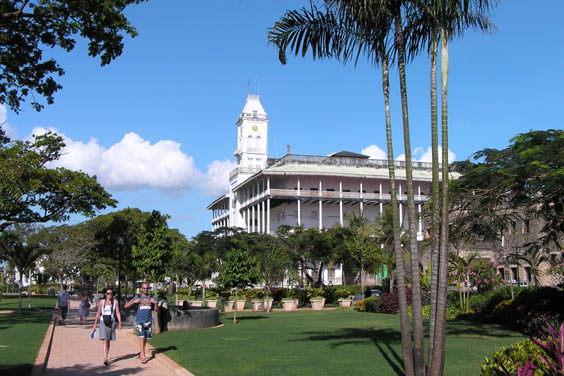Zanzibar
Zanzibar...even the name has an exotic and mystical ring to it, evoking childhood dreams of Sinbad the Sailor and stories of 1001 Nights. It lies 35km off the coast of mainland Tanzania and is situated in some of the Indian Ocean's most beautiful waters.
As far back as ancient times traders from India, Persia and Arabia used traditional rigged Dhow sail boats and the monsoon winds to reach present day Mozambique, Comoren Islands, and Madagascar, settling the East African coast. With them they brought fine silks, porcelain and spices - and the religion of Islam. Its teachings and culture became established in the 10th Century and the reach of Islam was extended from India to East Africa.
Stone Town, the capital of Zanzibar, was born of this trade; its deep natural harbour making it the ideal centre of trade and commerce from where mangrove wood, ivory and gold were exported. The island became the stopover point for caravans that journeyed deep into the African interior. Waiting for favourable winds, merchants would often have to bide their time here. This created the cultural melting pot of African Bantu, Persian, Arab and Indian peoples that still remains today.
In the beginning of the 16th Century Zanzibar was sacked by the Portuguese, the beginning of the colonial era for the island. The golden age of Zanzibar began under the Arabian Sultans of Oman, who were able to oust the Portuguese in the beginning of the 18h Century . In addition to the existing commerce the Arabian Omanian rule brought another trade... slavery.
Slaves were shipped and used in the sugar cane plantations of French-controlled islands of Mauritius and Reunion. They were also used for the development of date plantations in Oman. Zanzibar itself became very dependent on slaves with the growth of clove plantations. Holding the monopoly on clove production, thus propelling the island to its pinnacle of success in the 19th Century, it had the busiest slave market in the world, and it is estimated that more than 3 million slaves were transported from the shores of Zanzibar.
In 1840 the Sultan of Oman moved his court to Zanzibar. Following suit, many merchants from Oman, Gujarat and around the Indian Ocean moved their families from across the ocean to start a life in Zanzibar. This bustling capital city became very wealthy, and great fortunes were amassed. The influence of the English, abolishment of slavery and the collapse of the clove market put an end to Zanzibar's trade era during the 20th Century.
Stone Town today with its high stone houses still reflects the Omanian affluence that was once so prevalent. Everywhere you look Arabian architectural influences can be seen. Sturdy balconies and ornately carved thick wooden teak doors line its warren of twisting alleyways, winding past bazaars and mosques. This gives full testimony to this oriental island's history as a bustling hub of commerce and trade in the Indian Ocean.
In 2000 Stone Town achieved world heritage status. Along with its many historical tourist sights it also offers a wide range of restaurants and bars with many small shops adding to the attractive atmosphere.
Every year in the month of February the music festival "Sauti za Busara" takes place in the town's Old Fort, a perfect location for this five day event that attracts musicians from many different African countries. Excellent organisation and the diversity of musical influences makes this musical extravaganza an annual highlight, with visitors coming from all over the world. In July the Old Fort once again takes centre stage for East Africa's largest International Film and Art Festival.








